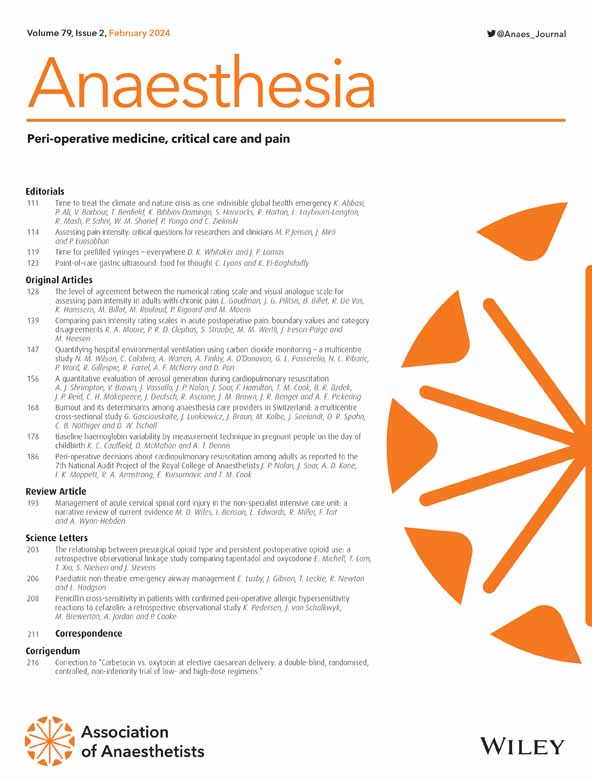比较囊周神经阻滞和髂筋膜阻滞对髋部骨折患者急性疼痛的治疗:一项随机临床试验。
IF 6.9
1区 医学
Q1 ANESTHESIOLOGY
引用次数: 0
摘要
髂筋膜阻滞(FIB)目前被推荐作为髋部骨折患者多模式急性疼痛治疗的一个组成部分。囊周神经阻滞是一种较新的技术,可以提供更好的镇痛效果。因此,我们在一个学术急诊科设计了这项研究,比较这两种入路对髋部骨折患者的急性镇痛效果。方法:报告至少中度疼痛的急性髋部骨折成年患者符合纳入条件。患者被随机分配接受20 ml 0.375%左布比卡因加4mg地塞米松的PENG阻滞或30 ml 0.25%左布比卡因加4mg地塞米松的腹股沟下FIB。主要结局是在阻滞后第一个小时内测量的视觉模拟疼痛评分计算的总疼痛强度差的百分比(%SPID)。次要结局包括:达到33%和50% SPID的患者人数;救援阿片类药物剂量吗啡毫克当量;以及不良事件的发生率。结果共筛选92例患者,入组64例(每组32例)。与FIB组相比,分配到PENG阻断组的患者显示出更高的%SPID(分别为62.7% (95%CI 52.9-72.4%)和38.0% (95%CI 30.7-45.4%);区别:-24.7% (95% ci -36.6 - -12.7%), p < 0.001)。在PENG组中,24/32的患者达到了50%的SPID,而FIB组为7/32 (p < 0.001)。同样,在PENG组中,28/32的患者达到33%的SPID,而FIB组为19/32 (p = 0.022)。在给予的阿片类药物剂量或不良事件发生率方面没有显着差异。与腹股沟下FIB相比,彭阻滞在干预后的第一个小时提供了更好的镇痛效果,代表了急诊科急性疼痛治疗的一种有希望的模式。本文章由计算机程序翻译,如有差异,请以英文原文为准。
Comparing the pericapsular nerve group block and fascia iliaca block for acute pain management in patients with hip fracture: a randomised clinical trial.
INTRODUCTION
The fascia iliaca block (FIB) is currently recommended as a component of multimodal acute pain management for patients with hip fracture. The pericapsular nerve group (PENG) block is a newer technique that may provide superior analgesia. We therefore designed this study in an academic emergency department to compare the acute analgesic effect of these two approaches in patients with a hip fracture.
METHODS
Adult patients with an acute hip fracture who reported at least moderate pain were eligible for inclusion. Patients were allocated randomly to receive either a PENG block with 20 ml 0.375% levobupivacaine plus 4 mg dexamethasone or infra-inguinal FIB with 30 ml 0.25% levobupivacaine plus 4 mg dexamethasone. Primary outcome was the percentage of summed pain intensity difference (%SPID) calculated from visual analogue pain scores measured during the first hour post-block. Secondary outcomes included: number of patients reaching 33% and 50% SPID; dose of rescue opioid administered in morphine milligram equivalents; and incidence of adverse events.
RESULTS
In total, 92 patients were screened for eligibility and 64 were enrolled (32 in each group). Patients allocated to the PENG block group showed a greater %SPID when compared with those allocated to the FIB group (62.7% (95%CI 52.9-72.4%) vs. 38.0% (95%CI 30.7-45.4%), respectively; difference: -24.7% (95%CI -36.6 to -12.7%), p < 0.001). In the PENG group, 24/32 patients achieved 50% SPID compared with 7/32 in the FIB group (p < 0.001). Similarly, in the PENG group, 28/32 patients achieved 33% SPID compared with 19/32 in the FIB group (p = 0.022). There was no significant difference in the rescue opioid dose administered or in the incidence of adverse events.
DISCUSSION
The PENG block provides superior analgesia for the first hour after intervention when compared with the infra-inguinal FIB and represents a promising modality for acute pain management in emergency departments.
求助全文
通过发布文献求助,成功后即可免费获取论文全文。
去求助
来源期刊

Anaesthesia
医学-麻醉学
CiteScore
21.20
自引率
9.30%
发文量
300
审稿时长
6 months
期刊介绍:
The official journal of the Association of Anaesthetists is Anaesthesia. It is a comprehensive international publication that covers a wide range of topics. The journal focuses on general and regional anaesthesia, as well as intensive care and pain therapy. It includes original articles that have undergone peer review, covering all aspects of these fields, including research on equipment.
 求助内容:
求助内容: 应助结果提醒方式:
应助结果提醒方式:


